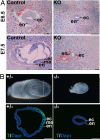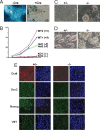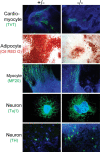ES cell pluripotency and germ-layer formation require the SWI/SNF chromatin remodeling component BAF250a
- PMID: 18448678
- PMCID: PMC2373334
- DOI: 10.1073/pnas.0801802105
ES cell pluripotency and germ-layer formation require the SWI/SNF chromatin remodeling component BAF250a
Abstract
ATP-dependent chromatin remodeling complexes are a notable group of epigenetic modifiers that use the energy of ATP hydrolysis to change the structure of chromatin, thereby altering its accessibility to nuclear factors. BAF250a (ARID1a) is a unique and defining subunit of the BAF chromatin remodeling complex with the potential to facilitate chromosome alterations critical during development. Our studies show that ablation of BAF250a in early mouse embryos results in developmental arrest (about embryonic day 6.5) and absence of the mesodermal layer, indicating its critical role in early germ-layer formation. Moreover, BAF250a deficiency compromises ES cell pluripotency, severely inhibits self-renewal, and promotes differentiation into primitive endoderm-like cells under normal feeder-free culture conditions. Interestingly, this phenotype can be partially rescued by the presence of embryonic fibroblast cells. DNA microarray, immunostaining, and RNA analyses revealed that BAF250a-mediated chromatin remodeling contributes to the proper expression of numerous genes involved in ES cell self-renewal, including Sox2, Utf1, and Oct4. Furthermore, the pluripotency defects in BAF250a mutant ES cells appear to be cell lineage-specific. For example, embryoid body-based analyses demonstrated that BAF250a-ablated stem cells are defective in differentiating into fully functional mesoderm-derived cardiomyocytes and adipocytes but are capable of differentiating into ectoderm-derived neurons. Our results suggest that BAF250a is a key component of the gene regulatory machinery in ES cells controlling self-renewal, differentiation, and cell lineage decisions.
Conflict of interest statement
The authors declare no conflict of interest.
Figures






References
-
- Surani MA, Hayashi K, Hajkova P. Genetic and epigenetic regulators of pluripotency. Cell. 2007;128:747–762. - PubMed
-
- de la Serna IL, Ohkawa Y, Imbalzano AN. Chromatin remodelling in mammalian differentiation: lessons from ATP-dependent remodellers. Nat Rev Genet. 2006;7:461–473. - PubMed
-
- Wang W. The SWI/SNF family of ATP-dependent chromatin remodelers: similar mechanisms for diverse functions. Curr Top Microbiol Immunol. 2003;274:143–169. - PubMed
-
- Roberts CW, Orkin SH. The SWI/SNF complex–chromatin and cancer. Nat Rev Cancer. 2004;4:133–142. - PubMed
Publication types
MeSH terms
Substances
Associated data
- Actions
Grants and funding
LinkOut - more resources
Full Text Sources
Other Literature Sources
Molecular Biology Databases
Research Materials

